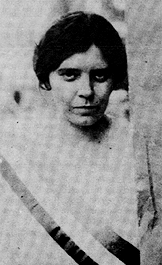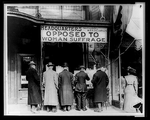By the 1880’s, women were seemingly on the road to achieving professional, legal, and educational equality with men. Elementary and secondary education was generally available to women. Higher education was also increasingly available to women.
States started to modify common law to give women more legal power. Wives were given control over their inheritance and earnings and even in some states, women were given a chance of winning at least joint custody of their children in the case of divorce. By 1900, 20% of the women in the U.S. were employed away from the home. In fact, a census taken in 1890 reported that women were represented in 360 occupations out of 369. Sadly, most employed women worked in textile and factory work with lower paid tasks and little chance for advancement.
On a more positive note, women’s image also changes. Although there was an emphasis for women to marry, women were also encouraged to pursue higher education and even a career. Medicine also changed for women. The theory that a woman’s reproductive system was the basis of her bodily functions started to be ignored. Menstruation and childbirth were looked upon as natural processes, not illnesses.

Public images like the “Gibson Girl” picture healthy and athletic women that were simply dressed, enjoying themselves playing tennis and golf, bicycling and even driving an automobile. Women, in turn, started to abandon trailing petticoats and ribbon gowns. Instead women slowly started to wear tailored suits or a dark suit with a simple blouse. Crinolines, bustles, and tight lacing of corsets were slowly abandoned, but most women wore some form of corset until the 1920’s.
Beginning in 1900, women’s attitude towards themselves started to change. Before, women’s goals in life was to marry, have children, and obey their husbands. These women would often give up their careers and education to do so. In fact, in 1900, only 5% of married women in the U.S. had gainful employment outside of the home. By 1910, this number increased to 11%. This changed however. More and more women started to devote their lives to their careers. Studies showed that in major Eastern women’s colleges, close to half of the alumnae were unmarried and supporting themselves in professional occupations. Women also had more information about sexuality and had more education and legal power. They now had more choices and voice in their relationships. One in twelve marriages in the U.S. ended in divorce by 1905. More and more women’s organizations started to appear. Unlike the chatty, gossip groups before them, these clubs focused on women’s concerns and rights. These groups brought public attention to issues varying from women suffrage to poor factory working conditions. Their impact was significant and useful, bring public support and demand for improved conditions.
Just as the women's suffrage movement started to come alive, an opposing movement, anti-suffrage, was born. The Anti-suffrage Society was formed in 1871. Typically, many psychologists and anti-suffragists associated feminism with mental illness. They came to the conclusion that most suffragists all bordered hysteria and their arguments could not be taken seriously. All women, they felt, were feeble minded, frail, physically weak, vulnerable, and intellectually inferior to men. By allowing the women to vote, it would expose and contaminate these women to the hysteric suffragist and it was their duty to protect women from such evil things. They also concluded that by allowing women to vote, the country's security would be jeopardized and ultimately lead to war. Also, because women were thought to be small brained, emotionally unstable, and irrational, voting would cause them added stress which they would not be able to handle. If women were to vote, they were thought by anti-suffragists to become more masculine. If men allowed women to vote, the men would become more effeminate. Quite bluntly, they felt the women's suffrage would turn the nation into a bunch of "transvestites".
Between 1890 and the First World War, the woman’s movement was extremely active and vigorous. By 1914, the women’s movement was focused on women suffrage. The women’s movement suffered numerous set backs though. The National American Women Suffrage Association or NAWSA had abandoned the congressional campaign and concentrated on the states. By 1910, only four states had equal women suffrage. These failures were partly due to opposing organizations of anti-suffragists, who believe that politics was no place for women. It was not over yet!

With new leaders, including a woman called Alice Paul, the NAWSA brought all new tactics and ideas into their campaign. Paul was not used to and also not happy with her small role though. She started her own organization called the Congressional Union in Washington DC. Although NAWSA and the Congressional Union used similar tactics such as parades, rallies and protests, the NAWSA focused on the state legislatures and the Congressional Union concentrated on Congress. Later on, the Congressional Union broadened it focus to state level and even made itself into a political party, called the Woman’s Party. Despite their differences, NASWA and the Congressional Union worked well together. When tension mounted and Congress repeatedly rejected the Women Suffrage Amendment, Alice Paul and the Woman’s Party turned to extreme measures. In 1917, they organized round the clock picket lines in front of the White House. They were arrested and jailed and also received national press coverage when they were force-fed after refusing to eat. Eventually, Congress passed the amendment in 1919. The amendment was annexed and made official on August 18, 1920 when Tennessee approved, giving women the right to vote.
Unfortunately, the 1920’s did not show such emphasis on women’s issues. After the Women’s Suffrage amendment was passed in 1920, women’s organizations splintered and disagreed on valuable causes for the women’s movement. Many veteran suffragists were worn out from the seemingly unending battle that took place just a decade before. They now felt that it was essential for them to return to the tasks they had pushed aside. Others felt women had reached liberation and equality, so there was nothing more for them to want.

This allowed anti-feminist undercurrents to rise up in society. The media was bombarded with the image of the happy housewife. Women were encouraged to take their place in the home again. In opposition to this image, the new generation of women took a whole new look. Rebellion against society’s standards was prominent and a free morality was set in. Young women took an attitude of free and easy living, fun and freedom. These “flaming youths” or “flappers” as they were later called, wore short skirts, smoked cigarettes, danced wild, new dances, and in general, enjoyed themselves.
The Great Depression hit the U.S. hard in the 1930s. It also started a work war among women. With the failing economy, the first to be laid-off were the married working women, who were “taking jobs away from men”, despite the fact that men now had reduced salaries that couldn’t support their families. Legislature in 26 states even had proposed bills that would prohibit the employment of married women. Women organizations took on a determined resistance against these and only one bill was passed, which was in Louisiana. Later on, it was ruled unconstitutional in the courts. Despite all the hostility, the number of employed women stayed basically the same as the 1920s. Women workers were still cheaper and certain fields of work were considered virtually closed to men. Men found themselves unemployed and often lost track of time, wandering the streets in disarray. Women’s lives were less disrupted by the depression than their husbands. Because of this, women became the center of stability in the family. Another result of the depression was a decline of divorces and an increase of marriages. Divorce was simply too expensive and marriage was seen as emotional support for young, single women in a time of uncertainty. Concerned about jobs and housing, people lost interest in the rebellious young style of the 20s and also the new moral standards.
Among all women, working or not, the return of tradition in their dress was evident. Although clothes remained loose and free flowing, skirts became longer and bosoms and small waistlines reappeared. This return was influence by new actresses and cinema queens, in which people in despair, felt they could some how live their lives through. The sweet virginal blond and the eluded temptress became a new twist of good-bad girl that dominated films. Women in the movies returned to their proper place, denied any real power. This came as a discouraging role model for women. Luckily, women’s screen roles changed slowly over the next few years. Their intelligence and strength started to shine through.

World War II brought major changes to the women and American work force. Six million additional women went work for the first time in the Second World War. Initially, it was not easy to persuade women to go to work, but the media slathered the image of “Rosie the Riveter”, the temporary women at work, everywhere. Women's guilt for working was a thing of the past. During the war years, four times as many women than men found employment in the federal bureaucracy. The government even paid lip service to the idea that men and women should receive equal pay and that childcare services should be established throughout the nation. Women were courted to join the work force, but they filled a majority of the factory, clerical, war related jobs. Once the war was over, some women happily left their jobs to return to their homes and marriages that were denied to them throughout the war. Other did not leave so happily. Cut-backs of women in the work force happened as soon as peace was declared. Business and factories simply did not need so many workers. Women were the majority of those laid-off.
By 1947, the number of working began to rise again. In 1951, 31% of all women worked. Conditions weren’t as bright as they seemed though. Women received lower paid salaries in factory and industrial work. There was nothing they could do though. No state legislature protected them. Despite these discriminations, a majority of these women stayed working.
Women’s role in American society was changing constantly from the 1880s to the 1950s. Their experiences and memories, defeats and triumphs are everlasting though. Women manage to catch America’s attention. Our founding mother’s cries were finally heard. Some equality was finally met. Women were finally recognized as humans and the path for future generation’s achievements and success was now laid out before them.